Formatting a Table
PowerPoint enables you to apply a variety of formats and borders to your tables, including the capability to do the following:
Apply different styles, widths, and colors
Insert and delete rows and columns
Merge and split cells
Align cell text to the top, bottom, or center
![]() You'll want to use the Tables and Borders toolbar to access PowerPoint's table formatting options. If this toolbar doesn't currently appear, you can open it by clicking the Tables and Borders button on the Standard toolbar or by selecting View, Toolbars, Tables and Borders. Table 4.1 lists the buttons on this toolbar.
You'll want to use the Tables and Borders toolbar to access PowerPoint's table formatting options. If this toolbar doesn't currently appear, you can open it by clicking the Tables and Borders button on the Standard toolbar or by selecting View, Toolbars, Tables and Borders. Table 4.1 lists the buttons on this toolbar.
You applied multiple formatting changes and want to undo something you did a few steps back? See the “Troubleshooting” section near the end of the chapter.
Merging and Splitting Cells
In PowerPoint, you can merge and split cells if you don't want to have the same number of rows or columns throughout your table. For example, you might want to merge all the cells across the top row of your table to serve as a title. You might want to split one cell into two if the content of that cell includes two separate sets of information.
To merge cells, select the cells you want to merge and click the Merge Cells button on the Tables and Borders toolbar. Figure 4.4 illustrates two cells that were merged into one.
Caution
If you already have text in each of the cells you merge, each cell text becomes a line of text in the new single cell.
To split a cell, select the cell you want to split and click the Split Cell button on the Tables and Borders toolbar. Figure 4.4 illustrates a cell that was split into two.
Figure 4.4. Merged and split cells have a variety of applications within a table.
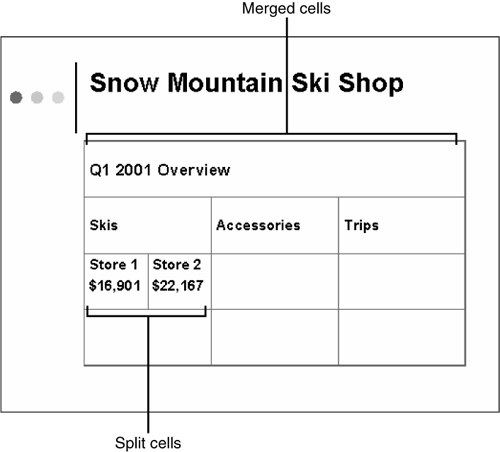
Creating a Border
Borders can add to the visibility of your table and can also add to its dramatic flair. PowerPoint tables include a black, solid line border by default, but you can change this. To apply border formatting options, select the table and then click the appropriate Tables and Borders toolbar button.
Setting Border Style
To set the border style, click the Border Style drop-down list on the Tables and Borders toolbar and choose the style of border you prefer. The list includes the option to apply no border, a solid line, or a variety of dashed line styles, shown in Figure 4.5.
Setting Border Width
To set the border width, click the Border Width drop-down list on the Tables and Borders toolbar and choose the width you prefer. Options include point sizes from 1/4 point (a very thin line) to 6 points (a thick line), shown in Figure 4.6.
Figure 4.5. Choose the border style that suits your table.

Figure 4.6. Use a thick border to create more emphasis, a thin border to create less.
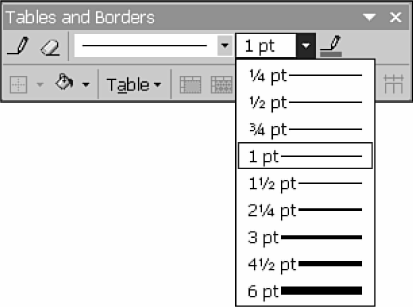
Setting Border Colors
To set the color for the table border, click the Border Color button. The box that appears offers several possible colors from which to choose, based on the presentation's color scheme. For additional color choices, click More Colors to open the Colors dialog box.
→ To learn more about the Colors dialog box, see“Using the Colors Dialog Box” in Chapter 6, “Formatting Slides and Presentations.”
Creating Outside Borders
You can specify which parts of your table contain borders—all of it or only specific outside or inside areas.
To set options for outside borders, click the down arrow to the right of the Outside Borders button on the Tables and Borders toolbar. A palette appears with several preselected outside border options, as shown in Figure 4.7.
Figure 4.7. You can have both inside and outside borders on your table.

Setting Table Fill Color
You can change the fill color of an individual cell or cells in your table if you want.
Caution
Be sure that your table text is still readable if you change a cell's fill color.
To change fill color, select the cell or cells that you want to change and click the down arrow next to the Fill Color button on the Tables and Borders toolbar.
You can
Choose from the colors that appear on the palette. If you applied a design template to your presentation, the colors that appear here complement the design template and will give you the best results.
Click More Fill Colors to display the Colors dialog box. You can choose from a large number of colors in this dialog box or create a custom color.
Click Fill Effects to choose from a number of gradients, textures, patterns, and pictures.
→ To learn more about the Colors and Fill Effects dialog boxes, seeChapter 6.
To remove a fill you no longer want, click the down arrow next to the Fill Color button and choose No Fill from the palette.
Working with Columns and Rows
After you create a table, you may decide that you need to add additional information or that you want to remove some of the data it currently contains.
Inserting Rows and Columns
To insert a new row into your table, select an existing table row by clicking the mouse in that row and then choosing Table, Insert Rows Above or Insert Rows Below from the Tables and Borders toolbar. PowerPoint inserts a row either above or below the selected row, depending on your menu choice. Figure 4.8 illustrates a table with an added row.
Tip from
You can resize the height or width of any row or column by selecting the row or column separator with the mouse and dragging it to the new location.
Caution
When you add or delete rows and columns, your table may no longer fit well on the slide. You then need to resize the table by dragging a corner with the mouse. Be careful, however, that you don't hide existing text by making the cells too small during resizing.
Figure 4.8. Add rows if you didn't create enough during the initial table creation.
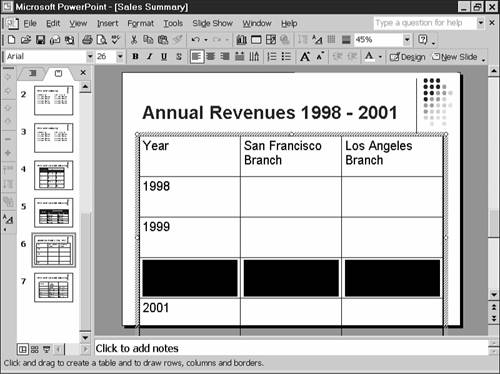
Your table no longer fits after inserting rows or columns? See the “Troubleshooting” section near the end of the chapter.
If you want to insert multiple rows, select that number of rows before selecting the Insert command. For example, if you select two table rows and then choose Table, Insert Rows Above in the Tables and Borders toolbar, two rows are inserted above the selected rows.
To add a new column to your table, select an existing table column by clicking the mouse in that column and choosing Table, Insert Columns to the Left or Insert Columns to the Right from the Tables and Borders toolbar. PowerPoint inserts a column either to the right or the left of the selected column, depending on your menu choice. Figure 4.9 illustrates a table with added columns.
Deleting Rows and Columns
To delete rows or columns, select the areas you want to delete and then choose Table, Delete Rows or Delete Columns from the Tables and Borders toolbar. PowerPoint deletes the entire column or row of the cell(s) you select.
Deleting Tables and Table Contents
To delete specific text in a table cell, select the text (not just the cell), and press the Delete key.
Caution
You must select the actual text or cell—not just place the cursor in the cell—to delete the text.
Figure 4.9. You can add columns if your table design changes.
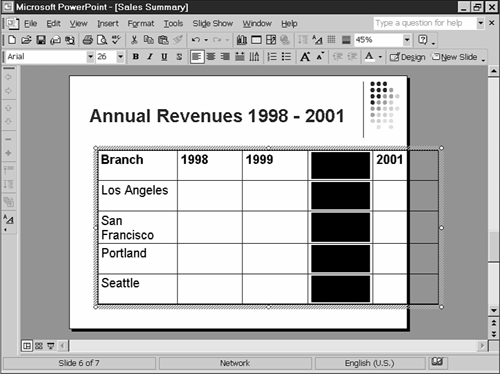
To delete an entire table, choose Table, Select Table from the Tables and Borders toolbar and then press the Delete key. The table disappears and is replaced by the initial Double Click to Add Table directive that appears when you first create a table slide.
Tip from
To delete a table, click the outside border of the table to select the entire table, and then press the Delete key.
Formatting with the Format Table Dialog Box
The Format Table dialog box (seen in Figure 4.10) duplicates much of what you can do from the Tables and Borders toolbar. However, it is a much more powerful tool if you want to do all your formatting from one location or if the Tables and Borders toolbar is closed and you don't want to open it again. You can access this dialog box in one of two ways:
Using the Borders Tab
The Borders tab enables you to set the following attributes:
Color Select a color from the drop-down list. For additional color choices, click More Colors to open the Colors dialog box.
Figure 4.10. Apply a multitude of formatting options from the Format Table dialog box.

→ To learn more about the Colors dialog box, see“Using the Colors Dialog Box” in Chapter 6.
Using the Fill Tab
Use the Fill tab, shown in Figure 4.11, to specify fill color for your table cells.
Figure 4.11. You can apply fill colors to your tables, but be sure the text is still readable.
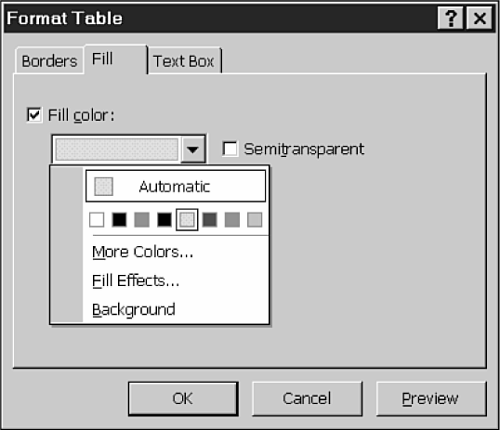
Click the Fill Color check box if you want to apply a fill color to your selected table cells. Select a color from the drop-down list. From here, you can also access the Colors and Fill Effects dialog boxes to apply additional color and fill options.
→ To learn more about the Colors and Fill Effects dialog boxes, see “Specifying Colors” in Chapter 14, “Creating and Formatting Objects.”
If you want to make the color display as Semitransparent, click the check box. Semitransparent colors can make it easier to view the slide's background and text.
Using the Text Box Tab
Use the Text Box tab, shown in Figure 4.12, to set alignment and margins in your table.
Figure 4.12. The Text Box tab enables you to set a variety of alignments.
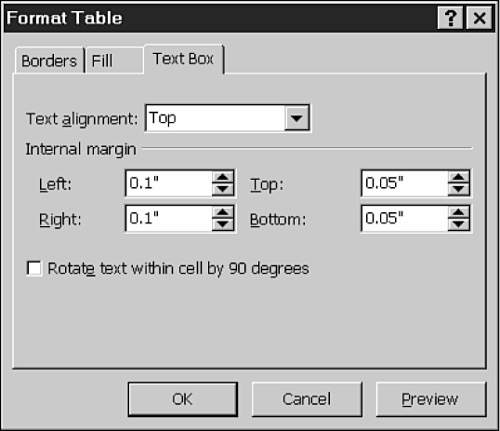
To set text alignment, click the drop-down list and choose from one of these alignment options: Top, Middle, Bottom, Top Centered, Middle Centered, or Bottom Centered.
You can also set internal margins for the left, right, top, and bottom margins within the table cells.
Select the Rotate Text Within Cell by 90 Degrees check box to rotate selected text vertically.
Adding Bulleted and Numbered Lists Within Tables
![]() To create a bulleted list within a table cell, select the cell you want to format and click the Bullets button on the Formatting toolbar.
To create a bulleted list within a table cell, select the cell you want to format and click the Bullets button on the Formatting toolbar.
![]() To create a numbered list within a selected table cell, click the Numbering toolbar button.
To create a numbered list within a selected table cell, click the Numbering toolbar button.
Tip from
For additional bullet and numbering options, select the text you want to format and then choose Format, Bullets and Numbering to open the Bullets and Numbering dialog box. This dialog box offers many additional options, including the capability to create alphabetical lists as well as picture bullets.
